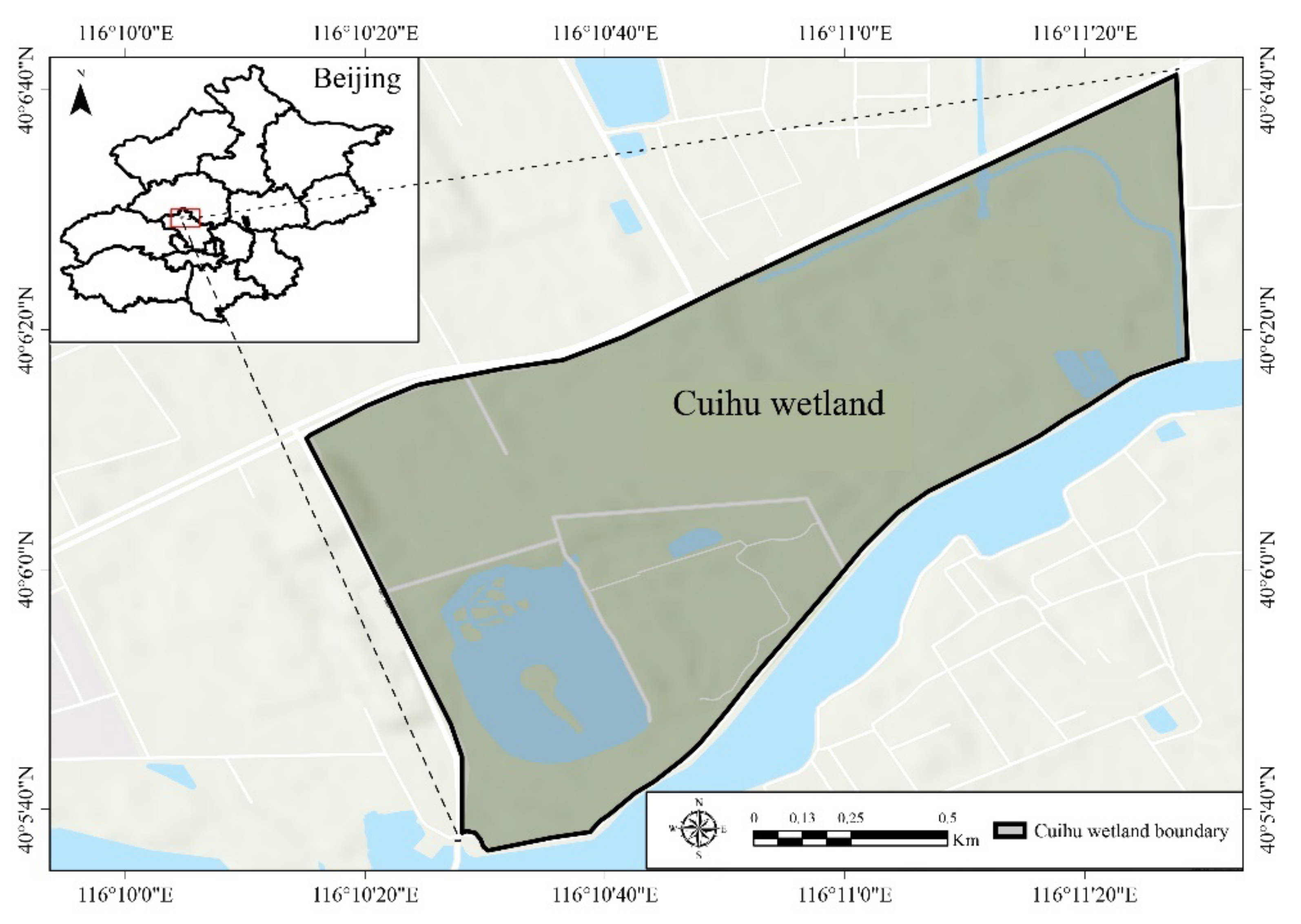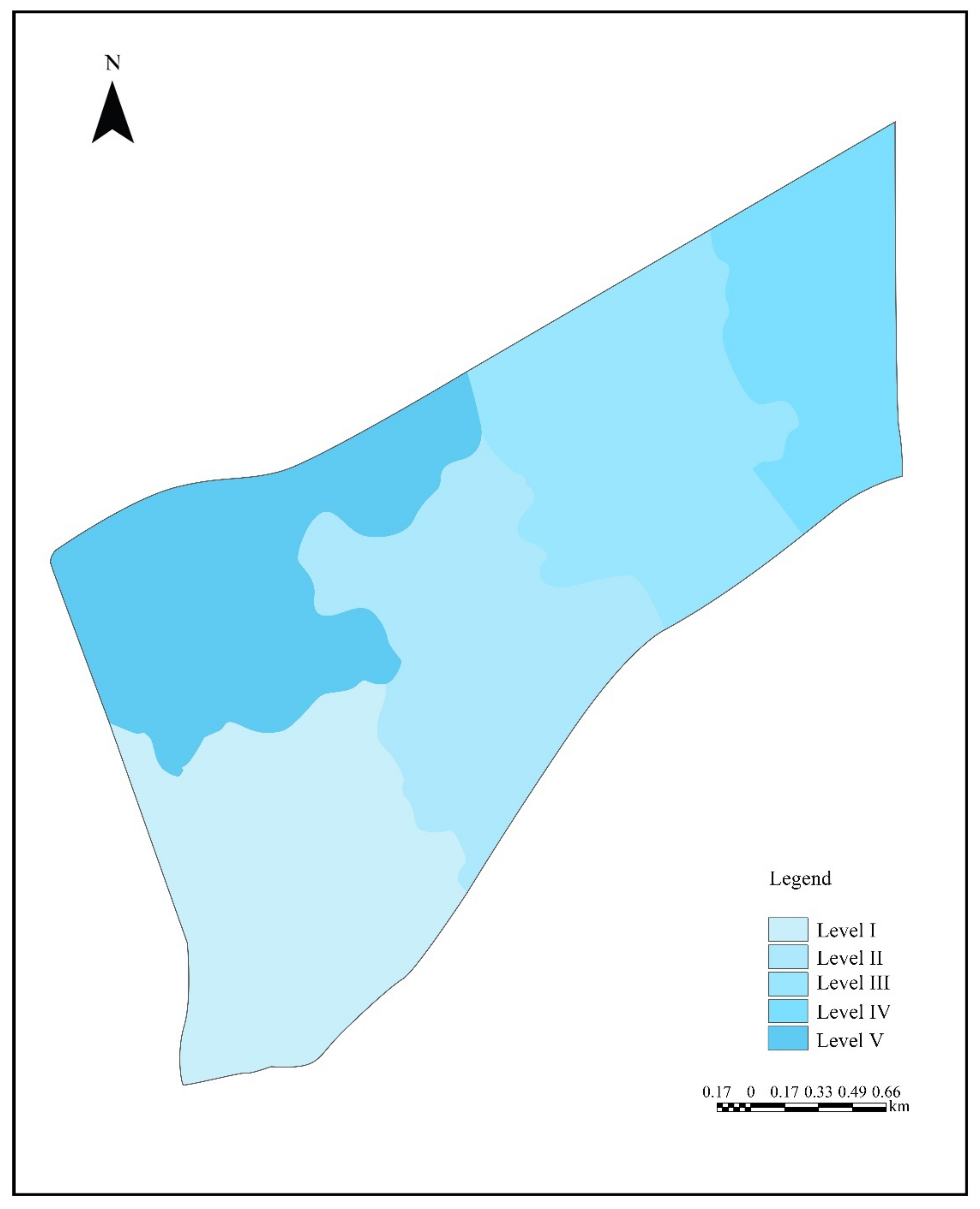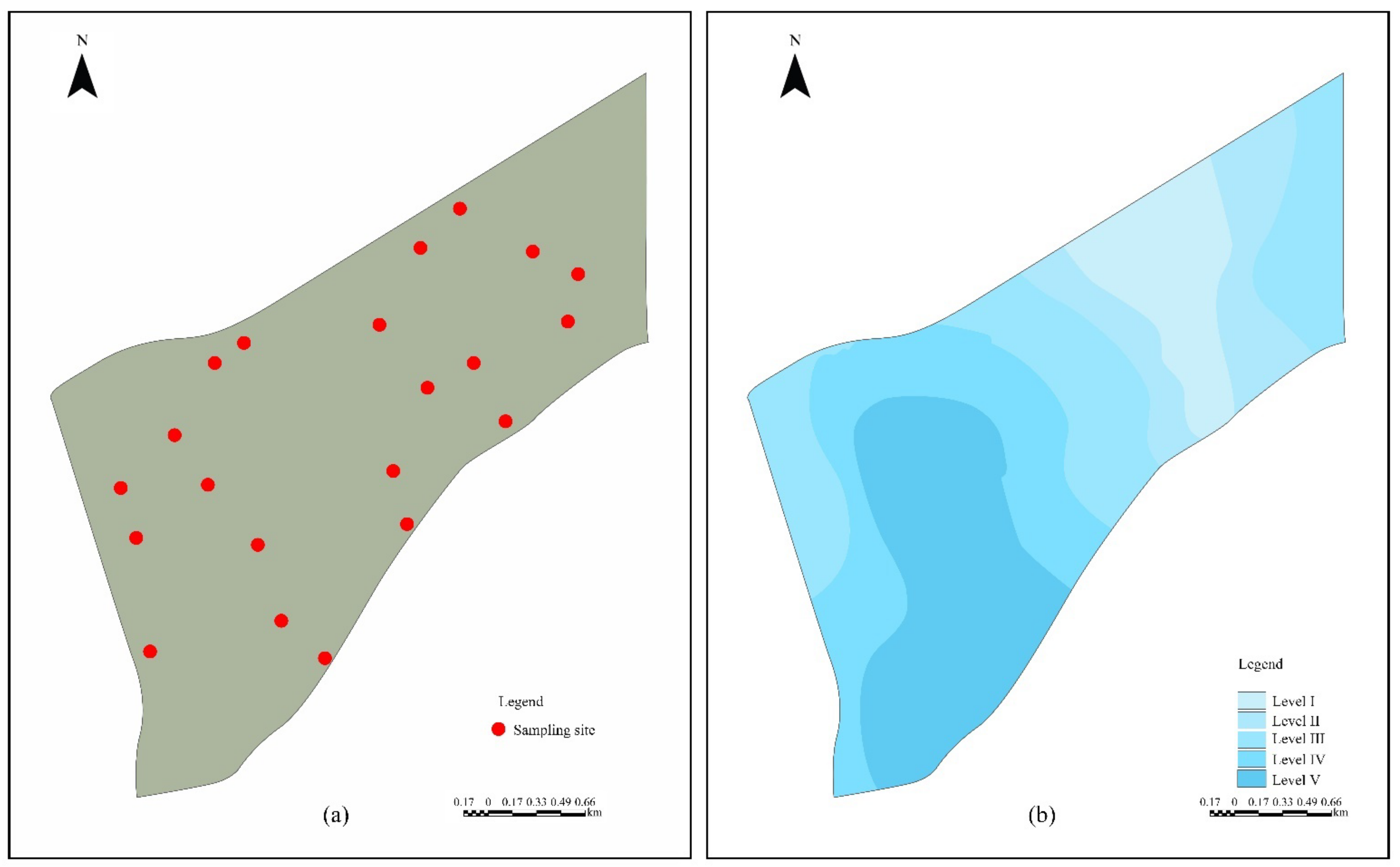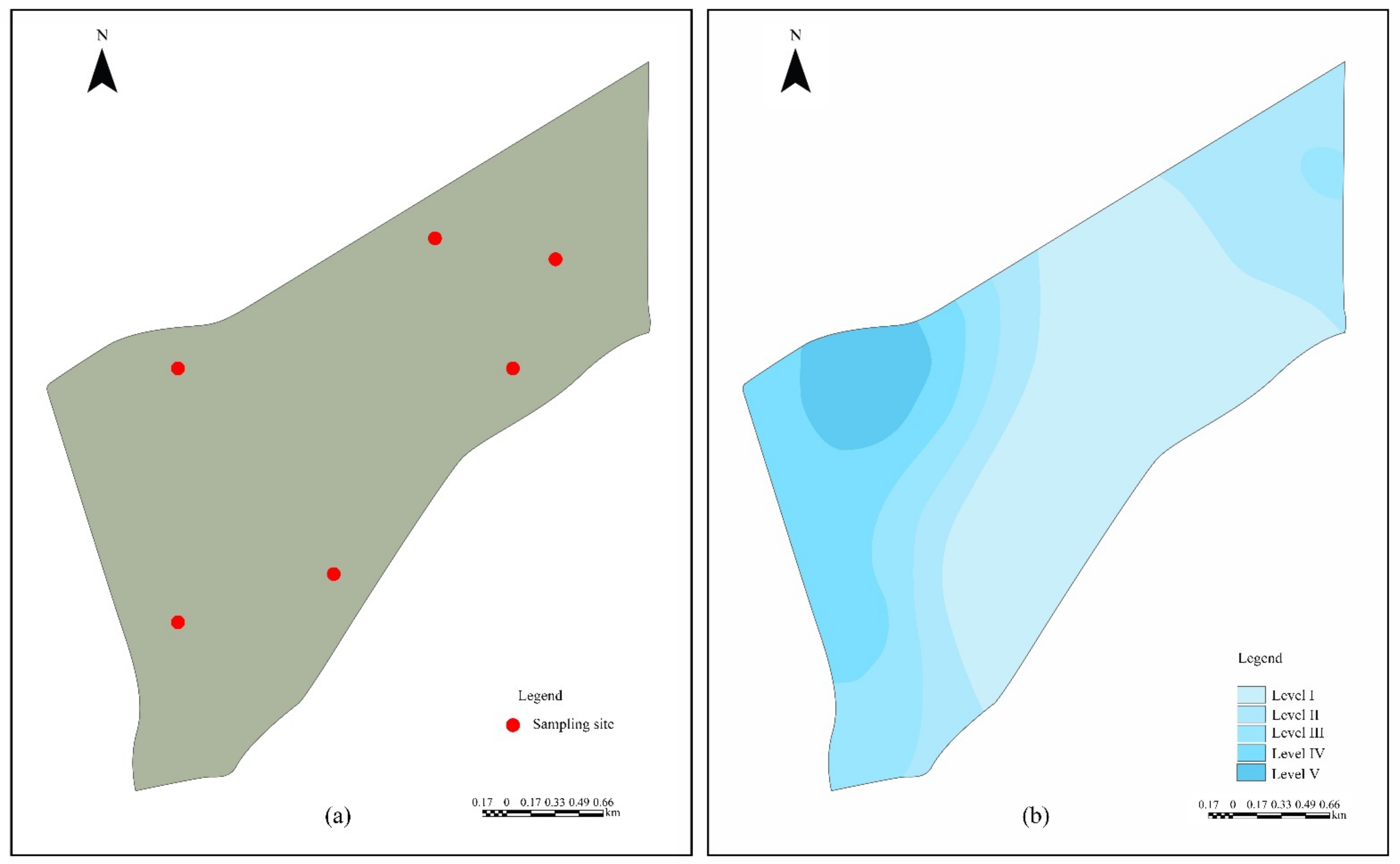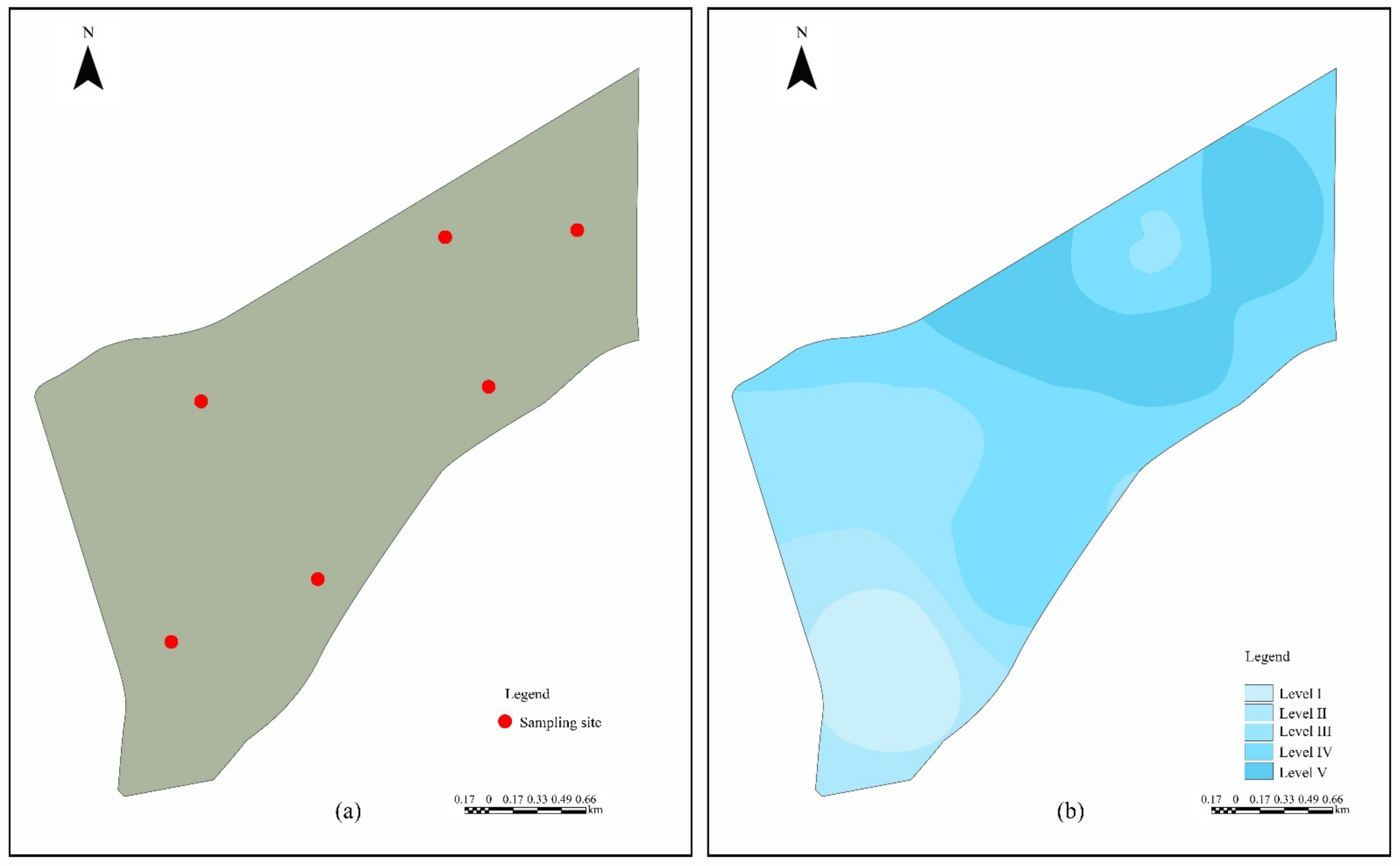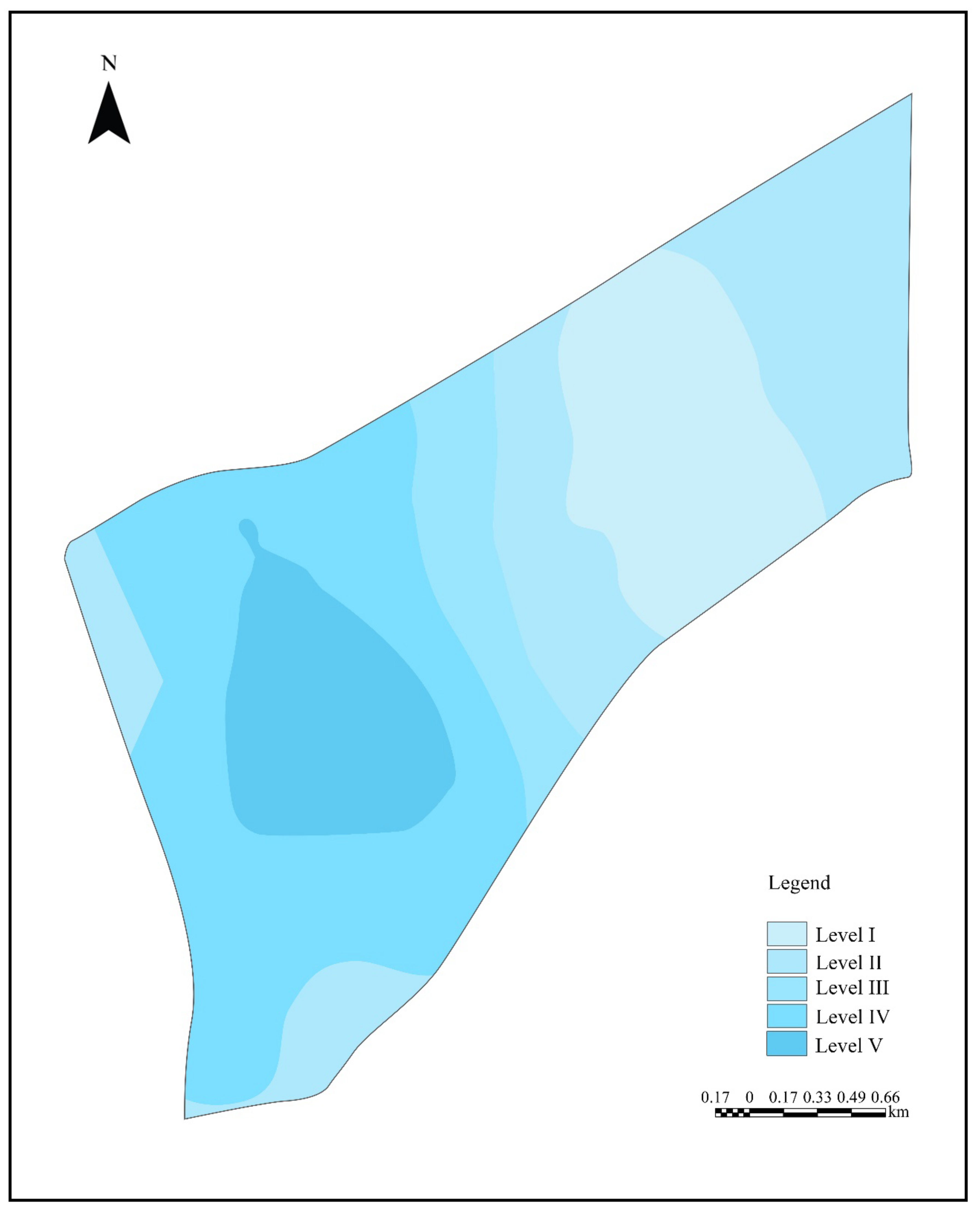1. Introduction
Wetlands are the transition zone between terrestrial and aquatic ecosystems [
1,
2], and one of the most complex ecosystems on the planet [
3,
4], with irreplaceable ecological functions [
5,
6]. Wetlands are known as the earth’s kidneys because they play an important role in flood control and water storage, climate regulation, water purification, humidification, and cooling. Wetlands are also known as biological supermarkets because they provide a living environment for animals and plants [
7,
8]. Wetlands are one of the most valuable ecosystems, with services they provide per hectare per year valued at USD 14,785 [
9,
10,
11]. Recently, with the increasing urbanization and human activities, wetlands around the world are facing severe challenges. Wetland ecosystems are suffering structural damage, gradual functional decline, significant reductions in wetland area, reduced biodiversity, severe water pollution, and eutrophication of water bodies [
12,
13,
14]. All of these issues indicate that the health of the wetland ecosystem has been severely damaged [
15,
16]. This will undoubtedly affect the watershed’s ecological security, as well as pose a threat to the development of the regional economy and human survival. Consequently, it is important to diagnose and evaluate the health of wetland ecosystems [
17,
18].
The evaluation of wetland ecosystems was pioneered in the United States in the early twentieth century to establish protected areas for migratory birds and rare wetland plants [
19,
20]. The United States began cataloging and evaluating the major protected species of wetlands in the 1950s [
21,
22]. The first rapid wetland evaluation model was developed by Larson in the 1970s [
17,
23,
24]. Subsequently, various countries have conducted exploratory and refinement work in studies of wetland health assessment. The Canadian Environmental Protection Agency primarily focuses on the health evaluation index system of lake wetlands and proposes an evaluation system that includes biodiversity indicators, chemical indicators, physical indicators, and social and economic status. Maitby et al. established a pan-European evaluation method of wetland ecosystem functions, conducting comparative studies in Ireland, the United Kingdom, Spain, and other countries and regions and establishing a sound evaluation system for riparian wetland systems [
25,
26,
27]. The Australian environmental protection department has also established a set of evaluation systems applicable to the Australian watershed wetland ecosystem, which primarily selects various indicators from environmental change trends, environmental background quality, and social and economic benefits to constructing the system [
28,
29,
30]. Previously, the United States conducted relevant research on wetland assessment and has achieved relatively fruitful results. With the advancement of wetland evaluation research in the United States, the three-level evaluation system established by the Environmental Protection Agency of the United States has gradually become a reference standard for researchers. The method has been used in Florida, Ohio, and other parts of the United States [
31].
Recently, China has also made some advances in the assessment of wetland ecosystem health. Wu et al. created an evaluation system based on the Element–Landscape–Society conceptual model to evaluate the health of the Zoige wetlands [
17]. Chen et al. used the integrated health index method to evaluate the ecosystem health of 19 wetlands in the Beijing–Tianjin–Hebei region in terms of water, soil, landscape, and social aspects [
32]. Wu and Chen developed a set of wetland health evaluation systems consisting of 12 indicators using remote sensing data and experimental data and then applied the system to the Hongze Lake wetlands [
33]. The ecosystem health of Chinese inland wetlands was assessed using the Pressure–State–Effect–Response model between 2010 and 2018 [
34]. A Pressure–State–Response model was used to assess the ecosystem health of coastal wetland vegetation in the Liao River Estuary [
35]. Furthermore, index of biotic integrity (IBI) methods began to be widely used in the health evaluation of wetlands [
36,
37,
38,
39,
40]. Different types of wetlands have been studied, primarily river and lake wetlands, but the evaluations of constructed wetlands are scarce. Overall, China has yet to establish unified evaluation criteria for the various types of wetlands.
Based on the comprehensive review of the literature, it can be found that most of the wetland ecosystem health assessment studies are still in the stage of single-level assessment. The evaluation methods mainly include species indicator method, PSR model, integrated index method, landscape pattern index, etc. However, the accuracy of single-level evaluation results is often not verified and has certain shortcomings. Furthermore, the proportion of constructed wetland area in Beijing is 52.5%, and its function and role are becoming more and more important during the process of urban development. Currently, research on constructed wetlands is more focused on functional services, such as wastewater absorption, conversion, and treatment [
4,
41,
42], and little research has been reported on the ecosystem health evaluation. Studies on the ecosystem health assessment of constructed wetlands need to be strengthened and advanced. The Cuihu wetland, as a typical case of an urban constructed wetland, has a wide range of promotional significance, based on the analysis of the research, and helps to promote the construction of urban wetland parks.
Therefore, this study adopted the three-level evaluation system proposed by the US EPA to comprehensively evaluate the health status of the Cuihu wetland ecosystem from different levels, in conjunction with the ecological environment of the study area. It is hoped that the results of the study will help enrich the evaluation system of urban constructed wetland ecosystem health and serve as a guide for the management of the Cuihu wetland.
4. Discussion
In the previous studies on the wetland ecosystem health assessment, most researchers chose natural wetlands for ecosystem health assessment, while studies on the evaluation of the health status of constructed wetlands were lacking. The effectiveness of conservation, management and restoration of constructed wetlands does not provide timely feedback to the relevant managers. Therefore, this study utilized the United States’ three-level framework wetland assessment method to evaluate the health of the Cuihu wetland ecosystem from different scales. On the one hand, it is hoped that the research results can provide some basic information for the management of the Cuihu national wetland park, and on the other hand, it is hoped that it can provide examples for the health evaluation research of artificially restored wetland, so that the optimized three-level framework evaluation method can be applied more widely.
The landscape development intensity index was selected after confirming its applicability to wetland health assessment in China [
49,
50]. Due to a lack of actual information on wetlands, the LDI coefficient proposed by Brown and Vivas was still used in this study for the more complex energy value calculation [
45]. Furthermore, if the landscape development intensity index is to be promoted and implemented, research into the tendency of localization of energy value calculation should be expanded. So, the LDI coefficients are more in line with the work of wetland-health evaluation in large-scale watersheds in China.
The selection of indicators in the rapid evaluation method has a certain degree of subjectivity and cannot evaluate all wetlands [
51,
52]. Consequently, in future rapid evaluation studies of wetlands, to improve the accuracy of the evaluation results, relative evaluation systems should be established for different wetland types and wetland function types.
Both the landscape development intensity index and the rapid wetland assessment method evaluate the naturalness or integrity of wetlands but do not directly consider the value of wetlands [
53,
54]. Consequently, the evaluation results of these methods should be viewed objectively. The actual score of some wetlands in landscape scale assessment or rapid assessment is low, which can only mean that the wetland has been subjected to significant human interference, but it does not imply that these wetlands lack value. The ultimate goal of wetland health assessment is to establish a sustainable wetland management method to realize the sustainable development of wetlands and humans [
4].
The Cuihu wetland is an artificially restored wetland landscape, fish are mostly artificially placed pathways into the waters. As a result, this indicator cannot be used to evaluate the IBI separately. Similarly, because the Cuihu wetland covers a small area, the observed birds are dispersed throughout the park, making it impractical to use birds as indicators of IBI evaluation. However, because the Cuihu wetland was mainly built with the concept of bird protection [
55], this study chose birds and fish as quantitative indicators to improve the rapid evaluation system of the Cuihu wetland.
In China, except for the core areas of some nature reserves, which have not yet been disturbed by human activity, all other areas have been subjected to varying degrees of human impact [
56,
57]. However, the Cuihu wetland is an artificially constructed wetland ecological landscape, so in the process of selecting the reference sites for the IBI, only relatively less disturbed points can be selected as reference sites [
58]. In this study, reference sites were determined by field investigation, soil fertility, and comprehensive consideration of multiple habitat types. To some extent, this method is subjective. It is hoped that in future research, to select reference points more scientifically, more accurate data such as the distribution of surrounding villages, population density, and highway density of sampling points can be obtained through remote sensing technology to determine the degree of interference of sample points and develop more accurate reference sites. Furthermore, the biological indicators screened in the IBI evaluation system are highly subjective. As a result, correlation analysis was used in this study to evaluate the correlation between each index and environmental factors [
59,
60]. It is hoped that in future related research, how to judge the relationship between biological indicators of biological integrity and environmental factors will be the main research direction to improve the biological integrity evaluation system.
An important reason for the higher ecosystem health for the Cuihu wetland area B, compared to that of area A, is the introduction of more plants in area B. As a wetland landscape constructed in the second phase of the Cuihu wetland, area B has a high recreational ornamental value, and a large number of ornamental plants were planted in the process of improving the ornamental landscape of the Cuihu wetland. However, the introduced plant species in the northern part and the southeastern part in area A were relatively simple and the survival rate was low. Moreover, the aquatic plant species in this region are single and less distributed. At the same time, the soil fertility in area B was also higher than that in area A, so the introduced plants had higher survival rate and grow better. Moreover, the benign plant environment provides good habitat for benthic animals, birds and fish. Therefore, the ecosystem of the Cuihu wetland area B is healthier than that of area A.
The existing problems of the Cuihu wetland include the following: low diversity of aquatic plants in the study area, the content of nitrogen, phosphorus, and potassium permanganate in water quality is high, the soil was weakly alkaline, and the contents of organic matter, total nitrogen, and total phosphorus were low. The alkaline soil often causes alkalinization of lake bottom mud and water quality, resulting in algae blooms in water bodies. Algae blooms increase the pH value of the water body, creating a vicious circle. Therefore, effective scientific monitoring methods should be used regularly to investigate the environmental health status of the Cuihu wetland ecosystem. Simultaneously, aquatic plant cultivation and propagation should be improved, and some new species suitable for the water environment should be introduced artificially. Effective methods should be used to improve water quality and reduce soil salinity to achieve the best health status of the Cuihu wetland [
61].
